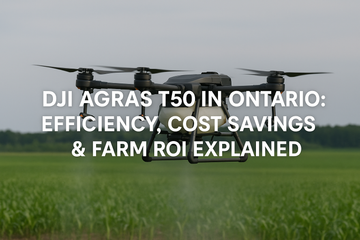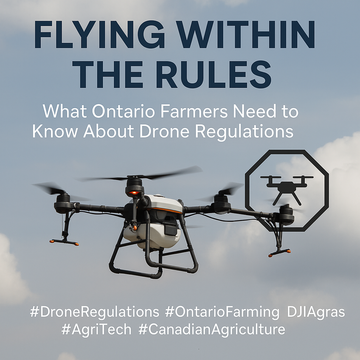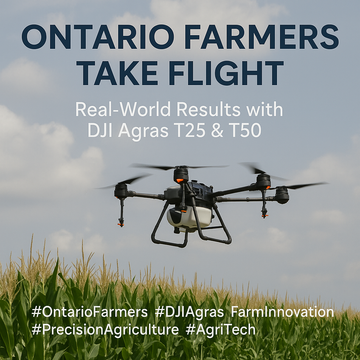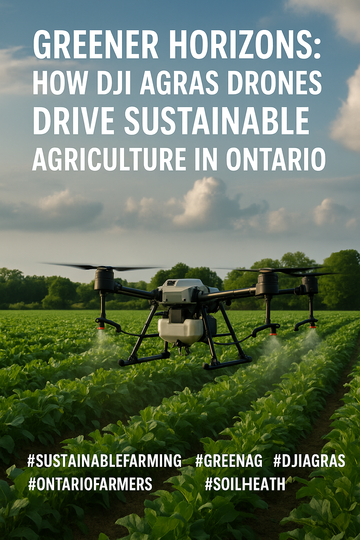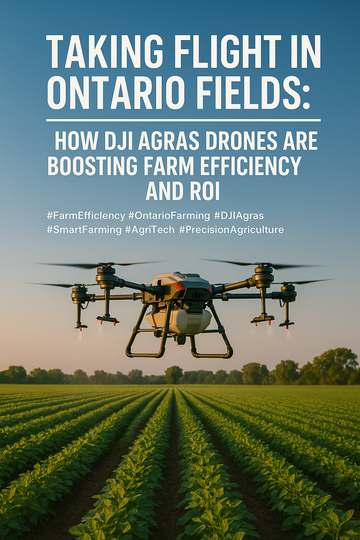Flying Efficiency: DJI Agras T50 in Ontario Agriculture
Drones are reshaping agriculture worldwide, but here in Ontario, farmers are asking the same questions: Is the DJI Agras T50 efficient? What kind of savings can it deliver? And is it even legal yet? Let’s dive in.
Efficiency in the Field
The Agras T50 is DJI’s flagship agricultural drone, designed to handle both spraying and spreading:
-
Spraying: Up to 21 hectares per hour (~52 acres), with a max flow rate of 16–24 L/min.
-
Spreading: A 75 L / 50 kg hopper, spreading up to 1.5 tonnes per hour across an 8 m swath.
-
Water logistics: Traditional ground sprayers may need ~15 gallons/acre, but drones can achieve coverage with ~5 gallons/acre—cutting water hauling by two-thirds.
In short, the T50 is built for high throughput with minimal downtime.
The Legal Reality in Ontario
Here’s the catch: commercial pesticide spraying by drone isn’t broadly permitted in Canada yet. Labels must explicitly state that an RPAS (Remotely Piloted Aircraft System) is allowed—and most don’t.
What is allowed?
-
Granular spreading (fertilizer, cover crops).
-
Non-pesticide spraying (biostimulants, nutrients, biologicals).
Since the T50 weighs over 25 kg, operators also need a Special Flight Operations Certificate (SFOC) from Transport Canada.
Savings from Multiple Angles
1. Water & Tendering
With ~66% less water needed, every acre saves time, hauling costs, and manpower. That means fewer tendering trucks and faster turns.
2. Yield Preservation
Ground rigs leave wheel tracks that can reduce yield by 1.3–2.5%. On soybeans at 55 bu/acre and $17/bu, avoiding those tracks means $12–23 saved per acre.
3. Timeliness & Access
The T50 flies over muddy fields or steep slopes—no ruts, no compaction, no waiting for drier weather.
4. Granular Efficiency
For cover-crop seeding or top-dress fertilizer, the T50’s 1.5 t/h throughput lets farmers work faster than many conventional spreaders, especially in sensitive field conditions.
Dollars & Cents in Ontario
-
Ownership cost: A T50 package in Canada runs C$36–41k. Spread over 3 years and ~1,500 acres/year, that’s ~C$11–13 per acre including labour and power.
-
Custom rates: Ontario’s 2025 averages are C$12/ac for fertilizer spreading and C$15/ac for spraying. That means owning a T50 is already cost-competitive.
-
Wheel-track avoidance alone: Often pays for the drone outright within a couple seasons.
The Ontario Playbook for 2025
Right now, farmers in Ontario are best positioned to use the T50 for:
-
Granular spreading (cover crops, fertilizer).
-
Non-pesticide spraying (nutrients, biostimulants, foliar feeds).
-
Hard-to-access fields where ground rigs cause damage.
Once Canadian pesticide labels evolve to include drones, the T50’s full spraying potential will unlock—and that’s when the water savings and yield protection could transform field economics even more.
Final Takeaway
The DJI Agras T50 is not just a drone; it’s a field logistics machine. While Ontario farmers must wait for full pesticide approval, the current opportunities—granular spreading, non-pesticide spraying, and compaction-free operations—already deliver measurable efficiencies and savings.
For many, the biggest advantage is not just lower costs per acre, but the freedom to fly when the ground is too wet, the crops too tall, or the window too short.
DJI Agras T50 Ontario
-
Agricultural drone efficiency Canada
-
Precision spraying and spreading drone
-
Farming cost savings Ontario drone
-
Drone fertilizer spreading Canada
#DJIAgrasT50 #AgricultureDrone #OntarioFarming #PrecisionAg #FarmTech #DroneSpraying #DroneSpreading #SustainableFarming #AgTechCanada


